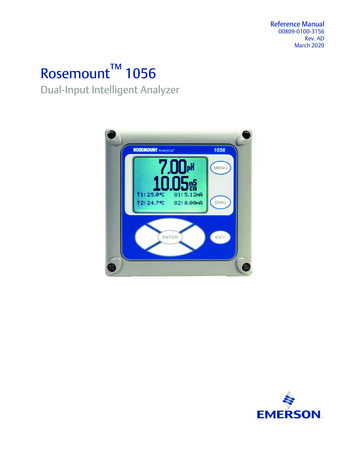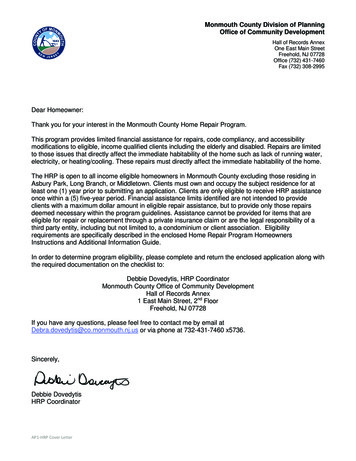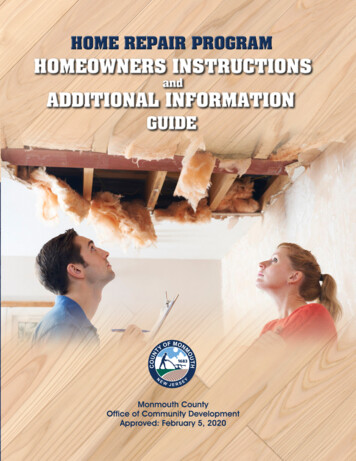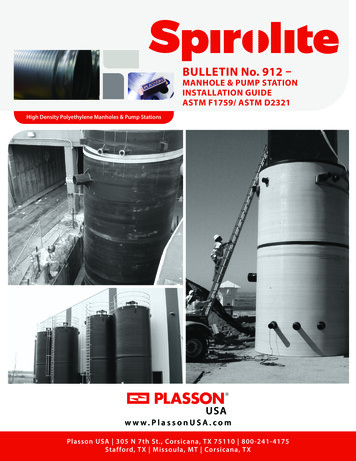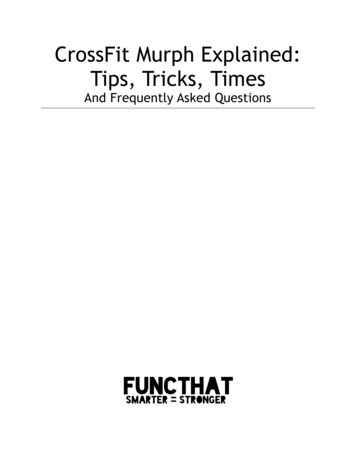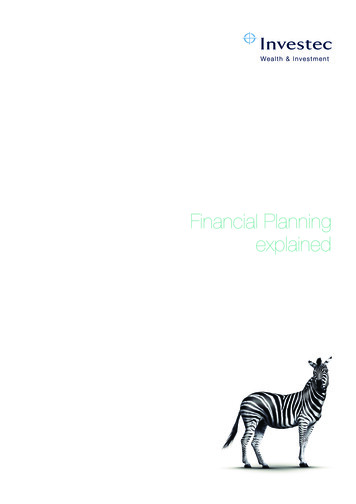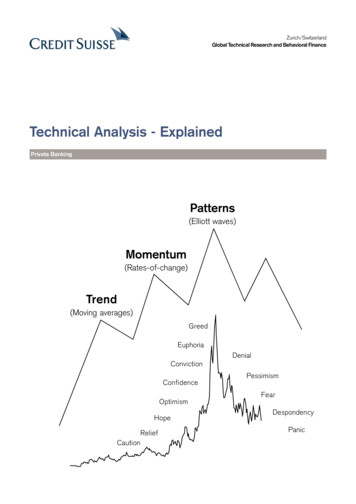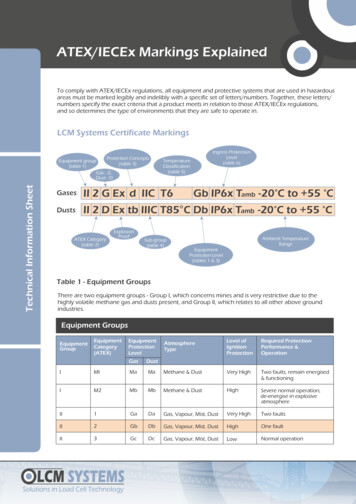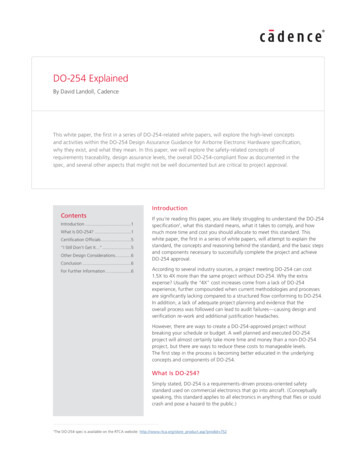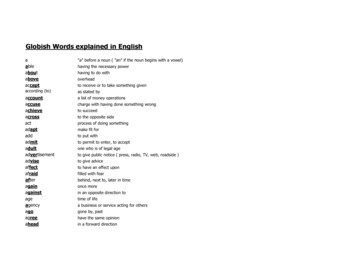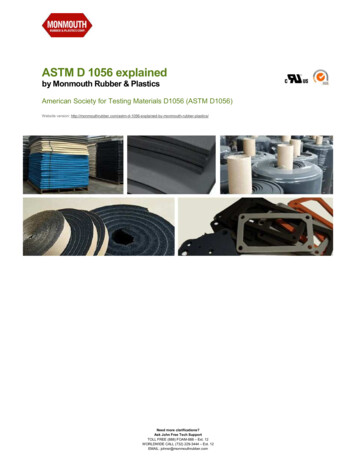
Transcription
ASTM D 1056 explainedby Monmouth Rubber & PlasticsAmerican Society for Testing Materials D1056 (ASTM D1056)Website version: -monmouth-rubber-plastics/Need more clarifications?Ask John Free Tech SupportTOLL FREE (888) FOAM-888 – Ext. 12WORLDWIDE CALL (732) 229-3444 – Ext. 12EMAIL: johnsr@monmouthrubber.com
1ASTM D 1056 explained Standard Specification For Flexible Cellular Materials – Sponge or Expanded Rubber Sponges (Open Cell) and Expanded (Closed Cell) Foams Reviewed and revised periodically ASTM D 1056-68 – The last two digits refer to the year of the test method issued (1968) If there is no year mentioned that means the most recent version of ASTM D 1056 is being referred to. Sponge products are identified by a three-character Grade Number (example: 2A2). The three characters represent Type, Class and Grade.Need more clarifications?Ask John Free Tech SupportTOLL FREE (888) FOAM-888 – Ext. 12WORLDWIDE CALL (732) 229-3444 – Ext. 12EMAIL: johnsr@monmouthrubber.com
2Type, Classes and GradesTypesTypes – These specifications cover two types of cellular rubber designated by the prefix numbers 1 and 2Type 1 Open Cell RubberType 2 Closed Cell RubberClassesClasses – Both types are divided into four classes designated by the letters A, B, C, and D added to the numberprefixClass A Cellular rubber made from synthetic rubber, natural rubber, reclaimed rubber, or rubber-like materials, alone orin combination, where specific resistance to the action of petroleum base oils is not required.Class B Cellular rubber made from synthetic rubber or rubber-like materials alone or in combination, having specificrequirements for oil resistance with low mass change.Class C Cellular rubber made from synthetic rubber or rubber-like materials alone or in combination, having specificrequirements for oil resistance with medium mass change.Class D Cellular rubber made from synthetic rubber or rubber-like materials alone or in combination having specificrequirements for extreme temperature resistance -103 to 347 F (-75 to 175 C): but specific resistance to the action ofpetroleum-base oils is not required.GradesEach type and class has been divided into a number of different grades.Each grade is based on specific range of firmness as expressed by compression-deflection. Grades are designated bydigit, the softer grades being identified with lower numbers and the higher grades being idenitified with the highernumbers.Grade 0 – For Types 1 and 2 cellular rubber, a compression deflection range from 0 to 2 psi (0 to 13.8 kPa)Grade 1 For Types 1 and 2 cellular rubber, a compression deflection range from 2 to 5 psi (13.8 to 34.5 kPa)Grade 2 For Types 1 and 2 cellular rubber, a compression deflection range from 5 to 9 psi (34.5 to 62.1 kPa)Grade 3 For Types 1 and 2 cellular rubber, a compression deflection range from 9 to 13 psi (62.1 to 89.6 kPa)Grade 4 For Types 1 and 2 cellular rubber, a compression deflection range from 13 to 17 psi (89.6 to 117.2 kPa)Grade 5 For Types 1 and 2 cellular rubber, a compression deflection range from 17 to 25 psi (117.2 to 172.4 kPa)Need more clarifications?Ask John Free Tech SupportTOLL FREE (888) FOAM-888 – Ext. 12WORLDWIDE CALL (732) 229-3444 – Ext. 12EMAIL: johnsr@monmouthrubber.com
3Suffix Letter Test RequiredA, Heat resistanceB, Compression set (B1 for 1A, 1B, and 1C only) (B2 & B3 for 2A, 2B, 2C, 2D only)BC, Ozone or weather resistanceCD, Load deflectionCE, Fluid resistanceF, Low-temperature resistanceBG, Tear resistanceCJ, Abrasion resistanceCK, Adhesion capabilityCL, Water absorptionDM, Combustion characteristicsCN, Impact resistanceCP, Staining resistanceBR, ResilienceBT, Tensile/ElongationBW, DensityZ, Special requirementsSuffix numbers that follow the suffix letter denote different testing parameters or conditions for that suffix.For e.g. B1 stands for C. Set at 70oC (158oF) and B2 stands for C. Set at 23oC (74.3oF) or Room Temp.BRatings to be arranged between the purchaser and the supplierCTest method and values to be arranged between the purchaser and the supplierCaution:Test Temperatures for Open Cell are higher than for Closed Cell and should NOT be used for Closed Cell.Example Line Call Out for Sponge ASTM D-1056 2C2 A1 B2 E1 Z (Z material passes FMVSS 302)2 – Closed Cell,C – Medium Oil Swell or Medium Oil Resistance2 – Compression Deflection (25% Compression) 5 to 9psi,A1 – Change in Compression Deflection after aging for 22h at 100 C to be /-30% from Original C.D.,B2 – Compression Set at 23 C for 22h (50% compression) and after 24h recovery to be max. of 25%,E1 – Test method and values to be arranged by the Purchaser and the SupplierZ States special requirement as detailed.Caution:Test Temperatures for Open Cell are higher than for Closed Cell and should NOT be used for Closed Cell.Need more clarifications?Ask John Free Tech SupportTOLL FREE (888) FOAM-888 – Ext. 12WORLDWIDE CALL (732) 229-3444 – Ext. 12EMAIL: johnsr@monmouthrubber.com
4ASTM D 1056 CHARTASTM D1056 -68ASTM D1056 -73ASTM D1056 -77ASTM D1056 -85ASTM D1056 -14RE41 BF1RE 41 BF1RE 41 B2F12A1 B2F12A1 B2F1SBE 43 BCF2RE 43 BCE2F2RE 43 B2C1E2F22B3 B2C1F22B3 B2C1F2SCE 42RE 42 E1RE 42 E12C22C2No SBE or SCE.Everything is REA-No OilresistanceB-Excellent OilResistanceC-Medium OilResistanceA-No OilresistanceB-Excellent OilResistanceC-Medium OilResistanceTypes: R (No OilResistance) and S(Medium to LowOil Resistance)No SBE andSCE. Everythingis REB1 – Only forOpen CellB2 & B3 – ForClosed CellSuffix B1 – C. Setat 70 C; Suffix B2– C. Set at 23oCType S Class SB Low Fuel Swell(50% Max.) orExcellent OilResistance ClassSC –MediumSwell, (150% Max)Suffix E1 –Medium OilSwell(150%)Suffix E2 –LowOil Swell (50%)Suffix E1 – OilResistance is anadd on to basicrequirements –values and testmethodsdeterminedbetweenpurchaser andsupplierNo allowance forDensities under 10pcfDensity LessThan 10 pcfgiven greaterallowance for OilSwell. E1-250%and E2 -100%Allowances forunder 10 PCF –see Specificationdetails.Grades: 40,41,42,43,44 and45Grades: 40, 41,42, 43, 44 and 4Grades: 40, 41,42, 43, 44 and 45Need more clarifications?Ask John Free Tech SupportTOLL FREE (888) FOAM-888 – Ext. 12WORLDWIDE CALL (732) 229-3444 – Ext. 12EMAIL: johnsr@monmouthrubber.comGrades: 0, 1, 2,3, 4 and 5Grades: 0, 1, 2,3, 4 and 5
5ASTM D 1056 MISCELLANEOUS MIL-C -3133; The same as D 1056 and was discontinued in 1986.SAE J18; The same as D 1056, discontinued.ASTM D1667; Very similar to 1056. Specifically for PVC containing closed cell foams.ASTM D3575; Similar to 1056 for polyolefin foams. Plastics like polyethylene and ethylene vinyl acetate.Need more clarifications?Ask John Free Tech SupportTOLL FREE (888) FOAM-888 – Ext. 12WORLDWIDE CALL (732) 229-3444 – Ext. 12EMAIL: johnsr@monmouthrubber.comMONMOUTH RUBBER & PLASTICS CORP75 Long Branch AvenueLong Branch, N.J. 07740 USAINT’L PHONE: (732) 229-3444TOLL FREE: (888) 362-6888Need more clarifications?EMAIL: SALES@MONMOUTHRUBBER.COMAsk John Free Tech SupportTOLL FREE (888) FOAM-888 – Ext. 12WORLDWIDE CALL (732) 229-3444 – Ext. 12EMAIL: johnsr@monmouthrubber.com
ASTM D 1056-68 – The last two digits refer to the year of the test method issued (1968) If there is no year mentioned that means the most recent version of ASTM D 1056 is being referred to. Sponge products are identified by a three-character Grade Number (example: 2A2). The three characters represent Type, Class and Grade. 1
